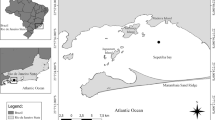Abstract
The validity of some morphological gyrocotylid species, exclusive gut parasites of ratfishes (Holocephali), is contested. Non-morphological characters, such as fatty acid profiles, may be used to resolve taxonomic problems. FiveGyrocotyle species were studied: three inChimaera monstrosa collected between 1985 and 1987 from the north-east Atlantic (on the Norwegian coast); and two inHydrolagus colliei, collected in 1987 from the north-east Pacific (in Nanaimo, British Columbia, Canada). Their fatty acids were obtained by methanolytic extraction of worm tissue samples, followed by gas chromatography of the fatty acid methyl esters, and finally multivariate data treatment (principal component analysis) of gas chromatographic results. Complete separation of the five species was obtained; classification agrees well with that arrived at by morpholog and enzyme electrophoresis.
Similar content being viewed by others
Literature cited
Albano, C., Blomqvist, G., Coomans, D., Dunn, W. J., Edlund, U., Eliasson, B., Hellberg, S., Johansson, E., Nordén, B., Sjöström, M., Söderström, B., Wold, H., Wold, S. (1981). Pattern recognition by means of disjoint principal components models (SIMCA). Philosophy and methods. In: Höskuldsson, A., Conradsen, K., Jensen, B. S., Esbensen, K. (eds.) Symposium i anvendt statistik 1981, January 21 to 23, 1981. Danmarks tekniske Højskole, Copenhagen, p. 183–218
Anderson, A. L., Arthington, A. H. (1989). Effect of dietary lipid on the fatty acid composition of silver perch (Leiopotherapon bidyanus) lipids. Comp. Biochem. Physiol. 98B:715–720
Bandoni, S. M., Brooks, D. R. (1988). Revision and phylogenetic analysis of the Gyrocotylidea Poche, 1926 (Platyhelmithes; Cercomeria: Cercomeromorpha). Can. J. Zool. 65:2369–2389
Bristow, G. A., Berland, B. (1988). A preliminary electrophoretic investigation of the gyrocotylid parasites ofChimaera monstrosa L. Sarsia 73:75–77
Bullini, L., Nascetti, G., Paggi, L., Orecchia, P., Mattiucci, S., Berland, B. (1986). Genetic variation of ascaridoid worms with different life cycles. Evolution 40:437–440
Colin, J. A., Williams, H. H., Halvorsen, O. (1986). One or three Gyrocotylideans (Platyhelminthes) inChimaera monstrosa (Holocephali)? J. Parasit. 72:10–21
Grahl-Nielsen, O., Barnung, T. (1985). Variations in the fatty acid profile of marine animals caused by environmental and developmental changes. Mar. envirl. Res. 17:218–221
Grahl-Nielsen, O., Tvedt, E. (1988). Selinvasjon på norskekysten. Hvor kommer selen fra? Naturen 1988:42–45
Grahl-Nieslen, O., Ulvund, K. A. (in press). Distinguishing between different populations of herring by chemometry of fatty acids. In: International symposium and educational workshop on fishmarking techniques, June 27 to July 1 1988 at Seattle, Washington.
Juhasz, S., Molnar, K. (1987). Gas chromatography: a prospective method for identifying fish parasites. In: Actual problems in fish parasitology. Abstracts of the 2nd intenational symposium of Ichthyoparasitology, September 27 to October 3 1987 at Tihany, Hungary, p. 39
Juhasz, S., Molnar, K. (1988). Identification of threePhilometra species by gas chromatography. In: Programme and abstracts of the 5th European multicolloqium of Parasitology. September 4 to 9 1988. Hungarian Society of Parasitologists Budapest, p. 111
Knutsen, H., Moksness, E., Vogt, N. B. (1985). Distinguishing between one-day-old cod (Gadus morhua) and haddock (Melanogrammus aeglefinus) eggs by gas chromatography and SIMCA pattern recognition. Can. J. Fish. aquat. Sciences 42:1823–1826
Kvalheim, O. M., Karstang, T. (1987). A general-purpose program for multivariate data analysis. Chemometrics and Intelligent Laboratory Systems 2:235–237
Nei, M. (1972). Genetic distance between populations. Am. nat. 106:283–292
Simmons, J. E., Buteau, J. H., MacInnis, A. J., Kilejian, A. (1972). Characterization and hybridization of DNAs of gyrocotylidean parasites of chimaeroid fishes. Int. J. Parasit. 2:273–278
Williams, H. H., Halvorsen, O. (1982). Are there sympatric species ofGyrocotyle inChimera monstrosa and isGyrocotyloides a fantasy? In: Mettrick, D. F., Desser, S. S. (eds.) Parasites — their world and ours. Abstracts 5th international congress of Parasitology. Molecular and Biochemical Parasitology, Supplement, Elsevier Biomedical Press, p. 336–337
Williams, H. H., Colin, J. A., Halvorsen, O. (1987). Biology of gyrocotylideans with emphasis on reproduction, population ecology and phylogeny. Parasitology 95:173–207
Author information
Authors and Affiliations
Additional information
Communicated by T. Fenchel, Helsingør
Rights and permissions
About this article
Cite this article
Berland, B., Bristow, G.A. & Grahl-Nielsen, O. Chemotaxonomy ofGyrocotyle (Platyhelminthes: Cercomeria) species, parasites of chimaerid fish (Holocephali), by chemometry of their fatty acids. Mar. Biol. 105, 185–189 (1990). https://doi.org/10.1007/BF01344285
Accepted:
Issue Date:
DOI: https://doi.org/10.1007/BF01344285




